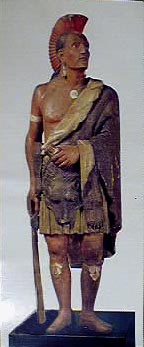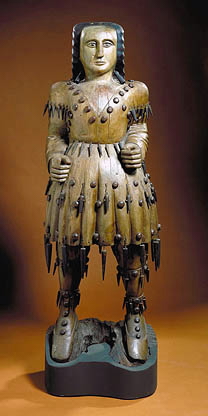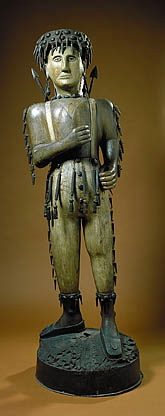




History ot the East Coast Cigar Store Indian Statue
The history and origin of the East Coast Cigar Store Indian dates back to England in 1617, when small wooden figures called "Virginie Men" were placed on countertops to represent tobacco companies. These "Virginians" (the local English renditions of Indians) were depicted as black men wearing headdresses and kilts made of tobacco leaves.









click on the email picture, or just click here
Commercial transportation for Tobacco cargo from Virginia and Immigration transportation to Virginia was contracted sailing vessels for the long oceanic crossing. Often identified by the brightly polychrome or gilded wooden figurehead, perched prominently on the front or bow of the vessel, under the bowsprit.
Wood carving, or wood sculpture, is one of the oldest and most
widespread forms of art. Because of the near universality of trees, the relative simplicity of the necessary technology, and the relative durability of the product, wood carving has been practiced in almost all cultures from the earliest times.
Professional carvers often paid for transatlantic voyage by carving or maintenance of previous carved ship figurehead and mast during the crossing. From approximately 1760 to 1880, however, these figures were often life-size human forms, either realistic portraits of prominent historical
figures or mythical ideal types, carved to stride, point, or look forward with serious mien.
The great sailing clipper ship along with professional wood carvers profession would soon be in jeopardy. The first transatlantic passage by a steam powered vessel was made in 1827.
As Steam Ships brought about the decline in sailing vessels the professional carvers turned their attention to new marketing enterprises. Most cigar-store Indians were carved in Eastern seaboard or Midwestern cities by artisans who might never have actually encountered a Native American; The figures look like white men in native garb. "In retrospect Experts believe that the population of Original Cigar-Store Indians made (said to be approximately 100,000 or so around the turn of the century) is now about several thousand or less."
The Cigar-Store Indian crosses the Atlantic Ocean for two reasons:
Economics and Sociology. In the American entrepreneurial spirit, some innovative tobacco sellers sought unconventional images for their trade signs to set them apart from the more established merchants.
The merchant customer often remembered the quality look and feel of specific wooden Indian over the products of the merchant. These Indians would enhance the flavor of high class cigar friendly smoking rooms, increase the appearance of fashionable hotel lobbies or go nicely on the
sidewalk of the local tobocconist shop.
At the same time, since the carvers were all competing among themselves for the tobacconists' business, each tried to out-do the other in individuality, versatility and depth.
Artists like the Skillin family, John Cromwell (most noted for his V shape headdress), Thomas Brooks (leaning statues) and Samuel Robb (Indian Maiden) operated full time studio's, employing staff carvers and painters to meet production demands. They put out catalogues of their product lines and frequently updated and expanded them.
From the mid-18th to the early 19th century the Skillin family of Boston produced preeminent carvers in wood. Ship figure-heads, architectural details, ornamental garden figures, and pediment figures of mahogany came from their shops.
Simeon Skillin, 1716-78, reputed to be America's first sculptor, received important commissions, primarily for ship carvings, but also for shop signs and portrait busts. Most notable was the shop established by John Skillin, 1747-1800, and Simeon Skillin, Jr., 1757-1806, which enjoyed a nationwide reputation. Their works testify to the contemporary enthusiasm
for allegorical abstraction and graceful neoclassical forms. The brothers' training and example influenced the style of subsequent wood carving in the United States.
The American-made Cigar-Store Indian were clothed in fringed buckskins, draped with blankets, decorated with feathered headdresses and sometimes shown holding tomahawks or bows, arrows and spears. Their facial features rarely resembled members of any particular American Indian.
Cigar-Store Indians were designed to capture the attention of the people walking by, informing them that tobacco was sold inside. It is said that the average cigar smoker in America in the late 1800s couldn't read the words "Tobacconist Shop".
America was quickly becoming a social melting pot of people with diverse origins. The average nineteenth-century American resident lacked a shared common language, and so the sidewalk cigar-store Indian was vital for business.
Visual trade signs were essentially stand-ins for written sign-posts that might have been incomprehensible to potential customers, many of them immigrants.
The carvers sculpted Indian chiefs, braves, princesses and indian maidens, sometimes with boarded papooses. Most of these displayed some form of tobacco in their hands or on their clothing.
Today in the late 20th century the best of the wooden Cigar-Store Indian antique sculptures sell for as much as $100,000.
The value of any one Cigar-Store Indian is determined by its condition, the artistic integrity of the form and the quality and intricacy of the carving in that order. The decisive factor is the condition of the wood finish.
A Cigar-Store Indian with its original paint is a almost impossible treasure to find and receives top dollar. Original Cigar-Store Indian paint finishes are extremely hard to find because the sidewalk statues were repainted on a regular basis as a routine maintenance and marketing measure.
As marketing "sign-posts", they were meant to appear fresh and welcoming, not peeling and faded. The original paint was applied in the sculptors workshop using a polychrome paint utilizing softer brush hairs than found on modern hand-brushes. The technique has produce a look
and feel of satin with an almost translucent glow. The essence of the over-all statue is lighter and more elegant than imaginable.
Throughout the years of ownership most Cigar-Store Indians experience replications by itinerant painters with a variety paint that had a completely different texture, finish and appeal. All collectors classify finding an original Cigar-Store Indian with original paint as being very unlikely.
Determining the artistic integrity of a statue is as subjective as judging any piece of sculpture. Each artist has a unique style. Since most of the statues are unsigned, they can be attributed to a particular artist or his shop by identifying characteristic modeling techniques or body positions.
Some artist elicited creations from quartered ship masts. Constricted by the diameter of the wood, the statues are often spindly. By turning them upside down, you can see the wood's straight grain and count the rings of the log to measure the age of the tree.
A few artists did used Native Americans as models. Thomas Brooks was
associated by the name "leaners," Wooden Indians resting their elbows on log posts, barrels or oversized cigars. John Cromwell's trademark was a distinctive V-shaped headdress. French Canadian Louis Jobin tended to place his Cigar-Store Indians with the left arm at chest level holding a robe and grasping a bundle of cigars in the right hand.
The man who probably made more Statues and perhaps most well known of all Sculptors in New York was Samuel Anderson Robb. His attendance of art school laid the ground work for gainful employment lasting for 60 years from 1864 until 1924.
After his first wife died, Sam Robb began fashioning sweet-faced indian maidens holding roses similar to the kind he designed for his wife's tombstone.
Where are all the elegant Cigar-Store Indians made by the American sculptors." The value of these sidewalk signs of yesteryear is rising like the cost of cigars themselves because of the passion for cigars and related collectibles.
Many of these pieces have survived; attributed to the fact that after the First World War, when production stopped and many had been "brought inside" as a result of the 1910 urban-sidewalk-obstruction laws. Countless Indian statues were sold from the commercial streets and slowly disappeared. As America survived the depression most wooden Cigar-Store Indians were broken and burned as firewood.
The 1990's have seen a renaissance in cigars, and Cigar-Store Indians being appreciated in America. The tradition of ladies and gentlemen enjoying a good cigar in the presence of our old wooden Indian friend has been reborn and is now being appreciated by all segments of society.






































Fall Creek Gallery - Old World Statue Shop
7752 Fall Creek Drive
Indianapolis, Indiana 46236
(317) 493-8583
Open Daily 12-6 pm EST

click on the email picture, or just click here
Cigar Store Indian Statue Resource Information Center at FALL CREEK GALLERY AND GARDENS
- Mr. Punch Cigar Store Figures
- History of the East Coast Cigar Store Indian Statues
- History of Western General Store Wooden Indian Statues
- History of Cigar Store Indian Sculpture's original Artists
- Tuesday's Tool with Julie Hollis for Saburrtooth Tools
- Cigar Store Indians Statues
- Custom Wood Sculptures
- Youtube Channel - Fall Creek Gallery
- Visit Our Studio
- Shipping & Picking Up Statues
Feel free to give Julie a call when your ready to place your order (317) 493-8583